Polypropylene pipes for heating: types, selection criteria, marking
A variety of materials are used to lay the communication systems necessary for heating air in residential and office buildings. It is worth considering carefully one of the most popular options - polypropylene pipes for heating.
They are inferior in some ways to steel and metal-plastic products, but surpass their characteristics in a number of indicators. In this article we will consider in detail the existing varieties of polypropylene pipes, the features of their labeling, the advantages and disadvantages of use.
We will also pay attention to the installation of a pipeline made of polypropylene and focus on the secrets of welding pipes from this material. In addition, we consider the best manufacturers supplying quality products at an affordable price to the market.
The content of the article:
Polypropylene and its properties
Polypropylene (PP) is a polymer that is part of the group of thermoplastics, that is, substances whose properties change depending on the indicators of the ambient temperature.
At 140 ° C, products from this type of plastic soften, and at 170 ° C they melt. The maximum temperature for their use is considered to be 120 ° C.
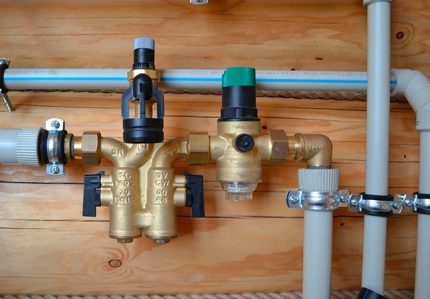
When using PP products, it is important to consider that this type of plastic has a pronounced thermal expansion. At high temperatures, polymer parts can expand significantly, for example, the length of a three-meter pipe increases by 3 cm.
The advantages of polypropylene pipes
Products made from this type of polymer have many advantages:
- have an integral design without a longitudinal seam;
- plastic parts do not corrode;
- light weight, facilitating transportation and storage;
- can be used even at high pressure;
- easy to install, which allows you to assemble structures yourself, without the involvement of professionals;
- polypropylene products can be used for a long time (50 years or more);
- the cost of such elements is lower than their analogues (steel, metal-plastic);
- have low thermal conductivity, so that heat loss is minimized;
- do not freeze at subzero temperatures;
- they practically do not create hydraulic resistance, which allows the water flow to move without noise and vibration;
- polypropylene products are considered environmentally friendly, they do not emit harmful substances, and water does not acquire odors;
- such elements are hygienic: polymers do not contribute to the development of unicellular plants and microbes;
- polypropylene products have an aesthetic appearance, they do not require painting or other decoration.
However, to take advantage of all these benefits, you must correctly pick up pipes for water supply or heating.
GOST for plastic pipes
Although there is no separate standard for polypropylene pipes, their quality and characteristics are noted in a single GOST R52134-2003. It lists the standards regarding mounting elements (pipes and fittings) made of thermoplastic materials that are used for heating communications and hot water.
These standards apply to products made from the following types of polymers:
- polybutene (PB, PB);
- polyethylene (PE, PE);
- chlorinated (PVC-C, CPVC) and unplasticized (PVC-U, Nvvc) polyvinyl chloride (PVC);
- crosslinked polyethylene (PE-X, PE-S);
- polypropylene, polymers of the same group (block copolymer, homopolymer, random copolymer).
The document also regulates the dimensional characteristics of pipes, conditions of use and all kinds of technical qualities, such as margin of safety, maximum temperature / pressure indicators (they determine the category to which this or that product belongs).
GOST R 52134-2003, the development of which took into account international standards and requirements for thermoplastic pipes, can be used to assess the quality of polymer elements.
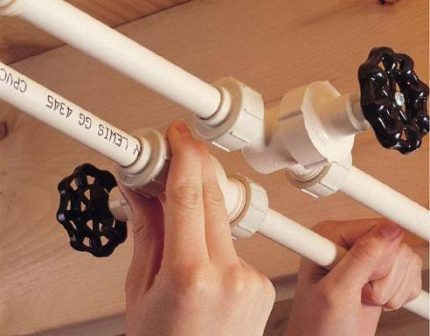
It should be noted that GOST R 52134-2003 in no case contradicts GOST 18599 (standard PE products) and GOST 51613 (standards for PVC), and complements them.
PP pipes are used for various construction works:
- when arranging centralized heating;
- organization of boiler plants;
- gaskets for cold / hot water supply;
- device risers;
- installation of "warm floor".
In addition, such elements can be used in agriculture for the construction of drainage systems and soil drainage, as well as in industry for the transportation of chemicals, including aggressive environments.
Varieties of propylene pipes
Since products from this type of plastic are produced in a wide range, there are several types of classifications.
Different color scheme
The assortment of polypropylene pipes presents products of different colors. The most common mounting elements are white, green, gray and black.
As a rule, the shade of products is chosen arbitrarily and depends on the design of pipes and manufacturers (some enterprises traditionally produce pipes of the same color, for example, green).
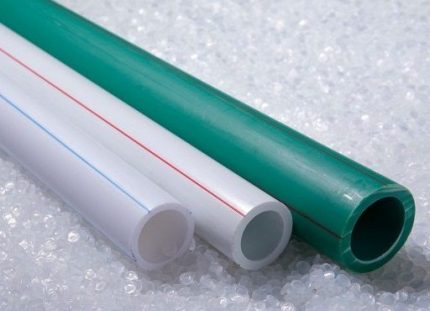
The one exception is the plastic products of a radically black hue. As a rule, this color is an indicator of the maximum level of protection against ultraviolet radiation.
Designs of various types
According to the internal structure, all polypropylene pipes can be distinguished into two fundamental categories:
- single-layer, consisting of one layer of plastic;
- multilayer (reinforced) of several shells, which consist not only of plastic, but also of materials that strengthen the structure, creating a strong frame.
Reinforced structures are preferable to a single layer, since in this case the temperature extension of the pipe is significantly reduced.
Varieties of multilayer pipes
There are several options for multilayer pipes. Most often, aluminum and fiberglass are used for reinforcement.
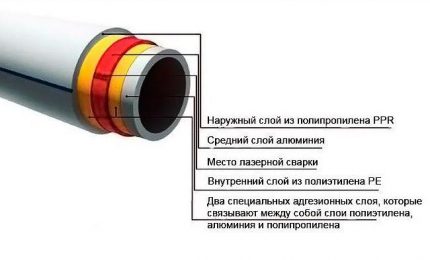
Pipes reinforced with a continuous sheet of aluminum foil. In the manufacture of such products, a smooth thin sheet of silver metal is applied to the outside of the polypropylene preform.
Before starting installation, such pipes must be cleaned by cutting the foil at a distance of about 1 mm from the edge. Skipping this process adversely affects the quality of the seam, which will turn out loose and unreliable.
Mounting elements, perforated aluminum sheet reinforcement. One of the layers of such pipes is foil with holes punched in it. As in the previous case, before using such parts, they should be cleaned.
It is important to consider that products with perforated foil have a high oxygen permeability coefficient, so it should not be combined with heating boilers or similar equipment.
Pipes with core reinforced with aluminum sheet. In this case, the products are strengthened in the middle or even the inner part, so that you can do without stripping before starting work.
Fiberglass Reinforced Parts. Of this durable material, the core of the pipe is most often made, while its internal and external parts are made of polypropylene.
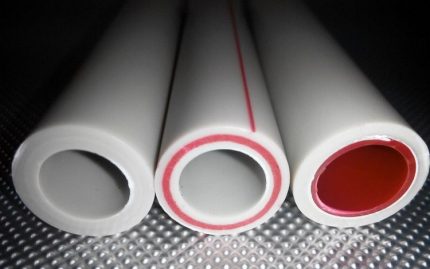
Composite reinforcement. For greater strength, a middle layer is also made in the pipes from the combined material, which combines polypropylene fiberglass. Such pipes also have high consumer properties and do not require stripping before use.
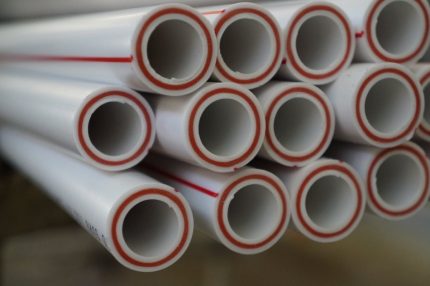
A variety of multilayer PP elements are pipes in which an additional layer of plastic is provided. Such products can withstand high temperatures, but contact between the transported liquid and the reinforced layer is not excluded.
In addition, coatings in such products are often glued together with glue, which under certain conditions can lead to delamination.
Labeling of polypropylene products
On all pipes made of this type of plastic, a certain combination of letters and numbers is applied, which contain an exhaustive characteristic of such products.
Pipe material designation
In the first place is usually the name of the manufacturer's company, followed by the type of material from which the products are made.
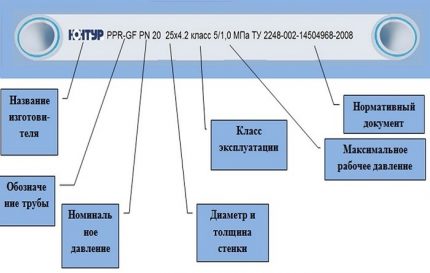
Several types of plastic are distinguished:
- PPH (PPH, PP-type 1, PP-1). Homopolier is the simplest type of polypropylene, for which raw materials are used with a small amount of modifying additives that increase impact strength. Products in this category, as a rule, have a large diameter. They find application in ventilation systems, drainage, outdoor water supply (cold).
- PPV (PP-type 2, PP-2, PPB). These letters denote a more complex type of PP - blockomer, which is characterized by a special molecular structure. Thanks to this, the plastic is characterized by increased resistance, which allows it to be used to create high-strength elements, installation of floor heating systems, communications for supplying cold water.
- PPR (PPRС, ППР, РР-3, PPR, PP-random). A type of polypropylene is a static copolymer (random copolymer). The crystalline arrangement of molecules in this material allows it to withstand wide temperature fluctuations, as well as shock loads. Copolymer pipes, the diameter of which can vary from 16 to 110 mm, are used for laying water supply, heating systems, sewers.
- PPs (polyphenyl sulfide). The polymer, which has tremendous resistance to high temperatures and physical stress, as well as improved indicators of strength, wear resistance. The diameter of this type of pipe can be in the range of 20-1200 mm. Products are used in various areas of construction work: ventilation, heating, hot / cold water supply.
Various manufacturers can apply all kinds of material markings, however, the letters PP always indicate that the pipe is made of polypropylene.
Maximum working pressure
Following the designation of the material, the working pressure is mandatory, which is indicated by two letters - PN - and numbers indicating bars (kg / square centimeter).
Such a combination of numbers and letters reflects the nominal pressure that pipes with which water flows at a temperature of 20 ° C over 50 years of operation can withstand.
The assortment of manufacturers presents products with markings PN25, PN20, PN16, PN10. Of these, for the heating systems and the arrangement of hot water supply, only the first two options can be used.
It should be noted that the maximum pressure that PP pipes can withstand is much higher. It is also important to consider that with increasing water temperature the resistance of the pipe to loads decreases significantly (at 90 ° C the pressure indicator drops from 20 to 6.5 bar).
Pipe diameter designation
The following numerical designation (from 10 to 1200) informs about the outer diameter of the pipe indicated in millimeters.
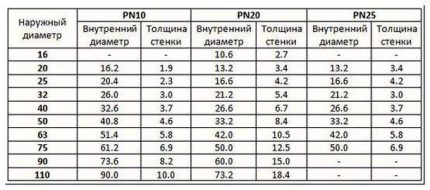
Products of various types are used in various fields of construction and installation works:
- 20 mm pipes are used to perform intra-apartment wiring;
- 25 mm - for risers of five-story works;
- 32 mm - for risers of buildings with 9 or more floors.
For ventilation systems and gutters used elements with a diameter of 400 mm and above.
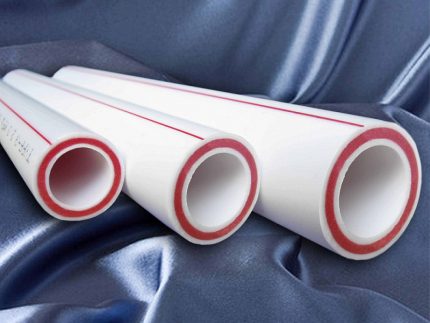
The diameter of the polypropylene pipes used for heating depends on factors such as temperature and the volume of fluid that will be transported through the mounting element. This value is closely related to the wall thickness of the pipes, as well as to the pressure that polypropylene parts can withstand.
Other indicators of polypropylene products
In addition, the following data are also indicated in the marking:
- Product design (single layer, marked).
- Date of issue. The combination allows you to find out the last two digits of the year, as well as the month and decade when the pipes were produced.
- Batch number, shift number, series of the production line where the product was manufactured.
- Information about GOSTwhich the product corresponds to (for domestic goods), as well as information on certification and the existing quality mark.
Some types of polypropylene pipes may also contain additional information on the marking.
Installation of systems from PP pipes and fittings
Polymer parts are easily interconnected using fittings and adapters or by the method of polyfusion welding, which requires special welding machine with nozzles. Using these methods, it is possible to assemble systems of various configurations.
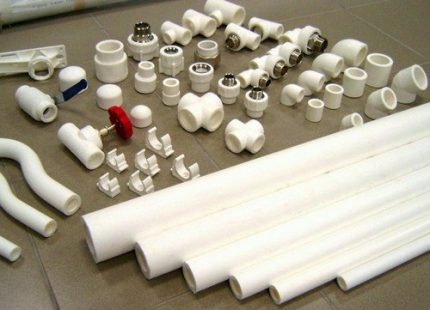
The installation of a heating system made of polypropylene does not require much time and special skills - it is enough to have some skills in processing plastic products and proper selection and installation of fittings.
And also follow a few simple rules:
- All work must be carried out at positive temperature (> 5 °).
- Protect polypropylene elements from contact with open flame.
- On PP parts, threading is prohibited.
- Before starting work, it is necessary to carefully inspect the products to prevent contamination and damage.
Since polypropylene has a linear expansion, the installation of parts requires the use of expansion joints, which are made of the same material as the pipes. Such elements are installed in places hidden from the eyes, which are best chosen in advance.
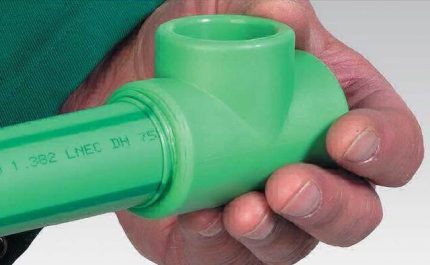
If, when laying a large-scale communications section, the installation of a compensator is difficult due to lack of space, it is advisable to provide a 5-10 mm gap provided for linear expansion in the circuit.
It should be noted that the expansion coefficient is less for pipes reinforced with aluminum than for their analogues with fiberglass, but the latter never break.
Heating pipe welding
For welding elements, it is necessary to use a special soldering iron, the regulator of which is set at 270 ° C.
Features of the choice of soldering temperature
When soldering, it is important to consider the ambient temperature: if the process takes place outdoors or in a cold room, the nozzle will cool down quickly.

For comfortable work in this case, it is better to increase the duration of the process or increase the welding temperature. It is desirable to extend the soldering time also in the case of connecting PP pipes having a large diameter. Detailed information on the soldering temperature with examples of specific values we have given in this article.
Step-by-step instructions for welding pipes
To solder two sections of the pipe made of polypropylene, a number of operations are necessary.
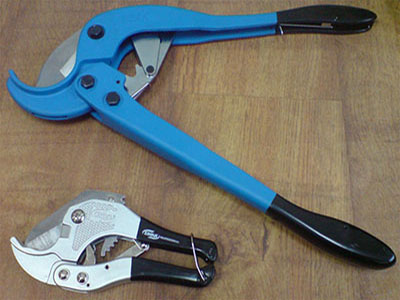
First of all, you need to measure the lower part of the pipe, and then cut it with a special tool - pipe cutter. If an aluminum-reinforced part is used for installation, first remove the upper and middle layers. Burrs are also removed from the stripped and cut end face of the element.
Using a marker on the pipe, the depth of the planned fitting entry is noted. To prevent narrowing of the passage, it is necessary to provide in the intervals a small (1 mm) interval between the protrusion and the end face of the fitting. On the surface of the pipe and mounting component, the marker marks the junction.
Elements are simultaneously mounted on two nozzles of the welding machine and heated for 5 seconds (the period can be increased when using large parts). After they are sufficiently warmed up, the workpieces must be removed from the nozzles and connected according to the applied marks, moving towards each other and evenly pressing down (but not screwing, as this may damage the layer).
It is important to control fasteners from all sides to prevent distortions in the radial / axial directions. The coupling should smoothly reach the flange, as a result of which an annular bulge, the so-called flanging, will appear on the pipe.
The seam cools down within 10-30 seconds, during which it is necessary to check the uniformity of the flanging, and if necessary, make a small correction of the connection.
After this, you can proceed to another stage of work, the plan of which is better to develop in advance.
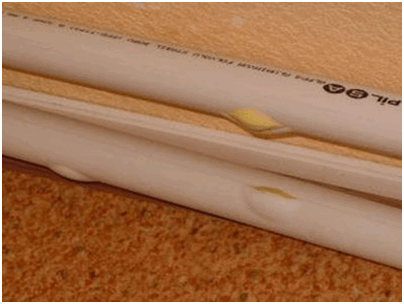
When carrying out welding work with plastic pipes, it is important to prevent overheating of the workpieces, which is easy to determine by darkening of the material. At excessively high temperatures, polypropylene can melt and clog the pipe, blocking the inside.
To avoid soldering errors and disastrous consequences as a result, we recommend that you familiarize yourself with welding rules.
Polypropylene Pipe Manufacturers
Polypropylene mounting elements are produced by various domestic and foreign companies.
The products of German companies are especially famous: Akwatherm, Rehau, Banninger, Wefathermwhich is distinguished by the highest quality and excellent design. There is one drawback - the price is too high.
Czech brands are equally popular. Fv-plast, Ecoplastik. Users on the forums are distinguished by the special elasticity of such products, which facilitates the processing (for example, trimming) of pipes of these brands, and in some cases even allows you to adjust the size of the cut section by stretching it a couple of centimeters.
Turkish manufacturers are also widely represented on the Russian market Vesbo, TEBO, Jakko, Firat, Pilsa, Kalde.
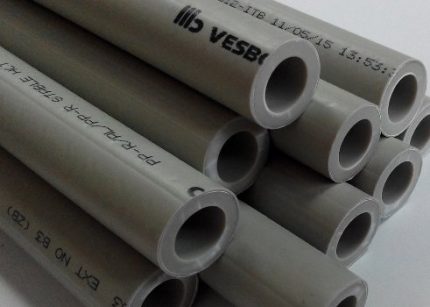
Among the many Chinese products, you should pay attention to the mounting elements. Dizayn, Blue ocean. They are distinguished by excellent performance and budget price.
Do not ignore the products of Russian companies. Products of firms Politek, Heisskraft, RVC, PRO AQUA, Santrade pleasing both quality and price.
Conclusions and useful video on the topic
The presented video will tell and show you how to navigate a wide range of plastic products designed for heating communications.
When choosing products from polypropylene, you need to get acquainted with their characteristics in order to accurately determine how much a pipe of one type or another corresponds to your desired purpose..
As a rule, in the product descriptions there are technical characteristics of the products, as well as their intended purpose, which allows you to make an unmistakable choice.
Picked up polypropylene pipes, but doubt their quality? Ask our experts and users for advice - many experienced home craftsmen will be able to share their own experience in operating a plastic heating circuit.
Or maybe you have theoretical knowledge on the topic of the article and want to supplement the material we have presented? Leave your comments, add recommendations - they will be useful to beginners.

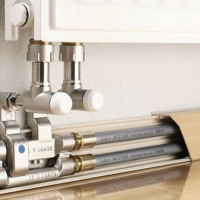 How to hide heating pipes: we disassemble the types of boxes and decorative linings
How to hide heating pipes: we disassemble the types of boxes and decorative linings  Voltage stabilizer for a gas heating boiler: types, selection criteria + overview of popular models
Voltage stabilizer for a gas heating boiler: types, selection criteria + overview of popular models 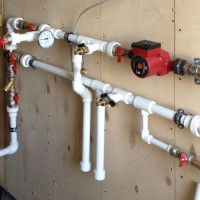 Pipes for heating boilers: which pipes are better for tying the boiler + installation tips
Pipes for heating boilers: which pipes are better for tying the boiler + installation tips 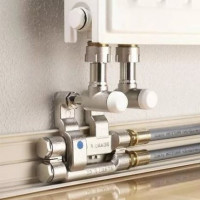 Which pipes are better to choose for heating: a comparative review
Which pipes are better to choose for heating: a comparative review 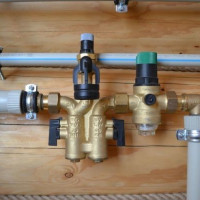 Installation of heating from polypropylene pipes: how to make a heating system from polypropylene
Installation of heating from polypropylene pipes: how to make a heating system from polypropylene 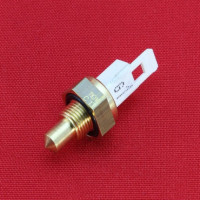 Temperature sensors for heating: purpose, types, installation instructions
Temperature sensors for heating: purpose, types, installation instructions  How much does it cost to connect gas to a private house: the price of organizing gas supply
How much does it cost to connect gas to a private house: the price of organizing gas supply  The best washing machines with dryer: model rating and customer tips
The best washing machines with dryer: model rating and customer tips  What is the color temperature of light and the nuances of choosing the temperature of the lamps to suit your needs
What is the color temperature of light and the nuances of choosing the temperature of the lamps to suit your needs  Replacement of a geyser in an apartment: replacement paperwork + basic norms and requirements
Replacement of a geyser in an apartment: replacement paperwork + basic norms and requirements
I had a house built. It took a cold and hot water supply. I decided, before hiring a team, I need to read all about such systems. I came across the information you proposed and carefully studied it, and then invited the workers. They believed that I did not know anything in this matter, and thought to deceive me a little with the choice of pipes and their diameter for the internal wiring device and risers. They wanted for risers a smaller diameter and unreinforced. They suggested cutting into pipes rather than welding. I broke up with them. Hired really knowledgeable.
I wonder why for the risers of hot water supply reinforced pipe? It is much more expensive, and the temperature of this circuit is usually up to + 50-60ºС. And the standard pp pipe PN 20 to + 70ºС is calculated.
On hot water, of course, purely theoretically there can be problems with linear expansion. But there is such a thing as a compensator, this is enough so that nothing bends.
I’ve already had about 12 years old in the house the usual, non-reinforced Ecoplastik pipes, I’m satisfied, high-quality and reliable.